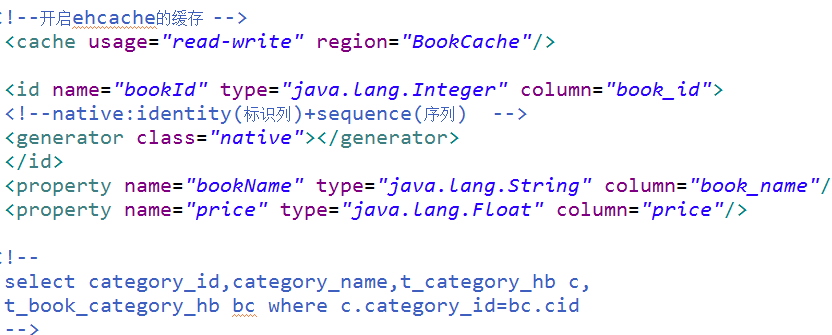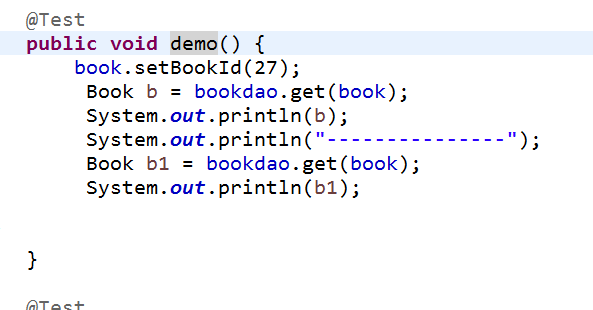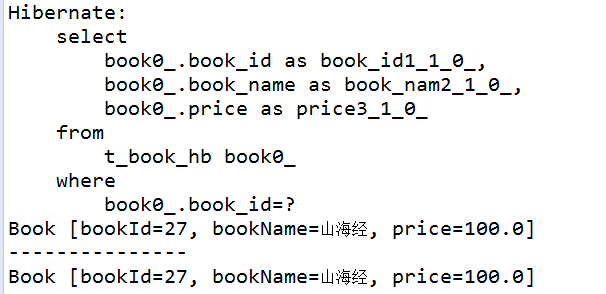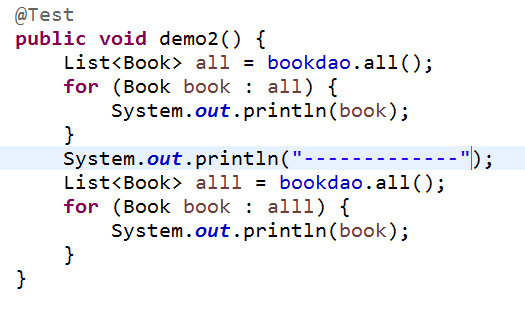1. 为什么需要缓存
拉高程序的性能
2. 什么样的数据需要缓存
很少被修改或根本不改的数据
业务场景比如:耗时较高的统计分析sql、电话账单查询sql等
3. ehcache是什么
Ehcache 是现在最流行的纯Java开源缓存框架,配置简单、结构清晰、功能强大
注1:本章介绍的是2.X版本,3.x的版本和2.x的版本API差异比较大
4. ehcache的特点
4.1 够快
Ehcache的发行有一段时长了,经过几年的努力和不计其数的性能测试,Ehcache终被设计于large, high concurrency systems.
4.2 够简单
开发者提供的接口非常简单明了,从Ehcache的搭建到运用运行仅仅需要的是你宝贵的几分钟。其实很多开发者都不知道自己用在用Ehcache,Ehcache被广泛的运用于其他的开源项目
4.3 够袖珍
关于这点的特性,官方给了一个很可爱的名字small foot print ,一般Ehcache的发布版本不会到2M,V 2.2.3 才 668KB。
4.4 够轻量
核心程序仅仅依赖slf4j这一个包,没有之一!
4.5 好扩展
Ehcache提供了对大数据的内存和硬盘的存储,最近版本允许多实例、保存对象高灵活性、提供LRU、LFU、FIFO淘汰算法,基础属性支持热配置、支持的插件多
4.6 监听器
缓存管理器监听器 (CacheManagerListener)和 缓存监听器(CacheEvenListener),做一些统计或数据一致性广播挺好用的
4.7 分布式缓存
从Ehcache 1.2开始,支持高性能的分布式缓存,兼具灵活性和扩展性
3. ehcache的使用
导入pom相关依赖
<!--ehche -->
<dependency>
<groupId>net.sf.ehcache</groupId>
<artifactId>ehcache</artifactId>
<version>2.10.0</version>
</dependency>
<!--hibernate与ehcache的二级缓存配置 -->
<dependency>
<groupId>org.hibernate</groupId>
<artifactId>hibernate-ehcache</artifactId>
<version>5.2.12.Final</version>
</dependency>
<!-- log配置:Log4j2 + Slf4j -->
<!-- slf4j核心包 -->
<dependency>
<groupId>org.slf4j</groupId>
<artifactId>slf4j-api</artifactId>
<version>1.7.7</version>
</dependency>
<dependency>
<groupId>org.slf4j</groupId>
<artifactId>jcl-over-slf4j</artifactId>
<version>1.7.7</version>
<scope>runtime</scope>
</dependency>
<!--用于与slf4j保持桥接 -->
<dependency>
<groupId>org.apache.logging.log4j</groupId>
<artifactId>log4j-slf4j-impl</artifactId>
<version>2.9.1</version>
</dependency>
<!--核心log4j2jar包 -->
<dependency>
<groupId>org.apache.logging.log4j</groupId>
<artifactId>log4j-api</artifactId>
<version>2.9.1</version>
</dependency>
<dependency>
<groupId>org.apache.logging.log4j</groupId>
<artifactId>log4j-core</artifactId>
<version>2.9.1</version>
</dependency>
<!--web工程需要包含log4j-web,非web工程不需要 -->
<dependency>
<groupId>org.apache.logging.log4j</groupId>
<artifactId>log4j-web</artifactId>
<version>2.9.1</version>
<scope>runtime</scope>
</dependency>
<!--需要使用log4j2的AsyncLogger需要包含disruptor -->
<dependency>
<groupId>com.lmax</groupId>
<artifactId>disruptor</artifactId>
<version>3.2.0</version>
</dependency>
ehcache.xml
<?xml version="1.0" encoding="UTF-8"?> <ehcache xmlns:xsi="http://www.w3.org/2001/XMLSchema-instance" xsi:noNamespaceSchemaLocation="http://ehcache.org/ehcache.xsd" updateCheck="false"> <!--磁盘存储:将缓存中暂时不使用的对象,转移到硬盘,类似于Windows系统的虚拟内存--> <!--path:指定在硬盘上存储对象的路径--> <!--java.io.tmpdir 是默认的临时文件路径。 可以通过如下方式打印出具体的文件路径 System.out.println(System.getProperty("java.io.tmpdir"));--> <diskStore path="java.io.tmpdir"/> <!--defaultCache:默认的管理策略--> <!--eternal:设定缓存的elements是否永远不过期。如果为true,则缓存的数据始终有效,如果为false那么还要根据timeToIdleSeconds,timeToLiveSeconds判断--> <!--maxElementsInMemory:在内存中缓存的element的最大数目--> <!--overflowToDisk:如果内存中数据超过内存限制,是否要缓存到磁盘上--> <!--diskPersistent:是否在磁盘上持久化。指重启jvm后,数据是否有效。默认为false--> <!--timeToIdleSeconds:对象空闲时间(单位:秒),指对象在多长时间没有被访问就会失效。只对eternal为false的有效。默认值0,表示一直可以访问--> <!--timeToLiveSeconds:对象存活时间(单位:秒),指对象从创建到失效所需要的时间。只对eternal为false的有效。默认值0,表示一直可以访问--> <!--memoryStoreEvictionPolicy:缓存的3 种清空策略--> <!--FIFO:first in first out (先进先出)--> <!--LFU:Less Frequently Used (最少使用).意思是一直以来最少被使用的。缓存的元素有一个hit 属性,hit 值最小的将会被清出缓存--> <!--LRU:Least Recently Used(最近最少使用). (ehcache 默认值).缓存的元素有一个时间戳,当缓存容量满了,而又需要腾出地方来缓存新的元素的时候,那么现有缓存元素中时间戳离当前时间最远的元素将被清出缓存--> <defaultCache eternal="false" maxElementsInMemory="1000" overflowToDisk="false" diskPersistent="false" timeToIdleSeconds="0" timeToLiveSeconds="600" memoryStoreEvictionPolicy="LRU"/> <!--name: Cache的名称,必须是唯一的(ehcache会把这个cache放到HashMap里)--> <cache name="BookCache" eternal="false" maxElementsInMemory="100" overflowToDisk="false" diskPersistent="false" timeToIdleSeconds="0" timeToLiveSeconds="300" memoryStoreEvictionPolicy="LRU"/> </ehcache>
EhcacheUtil
//定义缓存管理器,用于存放cache对象 private static CacheManager cacheManager; static { try { //读取Ehche核心配置文件的输入流 InputStream is = EhcacheUtil.class.getResourceAsStream("/ehcache.xml"); //根据核心配置文件创建EhcheManager缓存管理器对象 cacheManager = CacheManager.create(is); } catch (Exception e) { throw new RuntimeException(e); } } private EhcacheUtil() { } /** CacheManager -->Cache -->Element * 将缓存元素存储到缓存对象中,如果缓存对象不存在,则添加一个新的缓存, * 并将缓存元素存储到新的缓存对象中 * @param cacheName 缓存对象名Cache * @param key 缓存元素名称Key * @param value 缓存元素值 value */ public static void put(String cacheName, Object key, Object value) { //从CacheManager缓存管理器中获取缓存对象 Cache cache = cacheManager.getCache(cacheName); if (null == cache) { //以默认配置添加一个名叫cacheName的Cache cacheManager.addCache(cacheName); //获取新的缓存对象 cache = cacheManager.getCache(cacheName); } //将缓存元素存储到缓存对象中 cache.put(new Element(key, value)); } /** * 根据对象名从管理器中获取指定的缓存对象, * 然后再从缓存对象中获取指定的换成元素 * @param cacheName 缓存对象名 * @param key 缓存元素的key值 * @return */ public static Object get(String cacheName, Object key) { //从CacheManager缓存管理器中获取缓存对象 Cache cache = cacheManager.getCache(cacheName); //根据缓存元素的key获取缓存对象的缓存元素 Element element = cache.get(key); //获取缓存元素 return null == element ? null : element.getValue(); } /** * 根据缓存对象名获取缓存对象,并以缓存元素Key删除指定的缓存元素 * @param cacheName 存储对象名Cache * @param key 换成元素的key */ public static void remove(String cacheName, Object key) { //从CacheManager缓存管理器中获取缓存对象 Cache cache = cacheManager.getCache(cacheName); // //根据缓存元素的key删除指定的缓存元素 cache.remove(key); }
hibernate.cfg.xml 在这个核心配置里面手动开启二级缓存

给对应缓存的实体对象开启二级缓存

编写两个方法进行测试
public Book get(Book book) { Session session = SessionFactoryUtils.openSession(); Transaction transaction = session.beginTransaction(); Book b = session.get(Book.class, book.getBookId()); transaction.commit(); SessionFactoryUtils.closeSession(); return b; } public List<Book> all(){ Session session = SessionFactoryUtils.openSession(); Transaction transaction = session.beginTransaction(); String hql="from Book"; Query<Book> createQuery = session.createQuery(hql, Book.class); //指定缓存策略,名字必须实体类的完整类名 createQuery.setCacheRegion("BookCache"); //手动开启二级缓存 createQuery.setCacheable(true); List<Book> list = createQuery.list(); transaction.commit(); SessionFactoryUtils.closeSession(); return list; }


可以看到,查询两次,只产生了一条sql语句,说明缓存生效了
查询全部


查询全部需要注意的点就是加下面这两行代码,不然是缓存是不生效的
